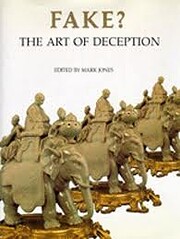

Klik på en miniature for at gå til Google Books
|
Indlæser... Fake? The Art of Deceptionaf Mark Jones (Redaktør)
 Literary Forgeries (13) Der er ingen diskussionstråde på Snak om denne bog.  Absolutely fascinating from the layperson's point-of-view. My only quibble is that there are not photographs for each entry, even though the references in the text indicate that there should be. But what is there is excellent. I wonder if there is a more fully illustrated edition available? Or if the decision to not include some photographs was made just before publication. This is one of the best books for those interested in forgeries of art works, and it also contains commentary of reproductions of some literary forgeries. What makes it so outstanding is the numerous illustrations, generally in color, of forged objects, often placed next to objects that they imitate. The chief complaint that I have about the pictures is that not every object in the exhibit is pictured, but it is even so a very large book. Thomas Hoving drew upon this work in writing False Impressions, so it is well worth having on hand to reference when reading his book. This book also discusses the many gray areas in reproductions. Copying other artists' work is a legitimate form of training, high quality reproductions are made as souvenirs, or for people content with imitations (I several pieces from the New York Metropolitan of Art) and these may later be taken for original works if there were not carefully marked as imitations. Further, in other times, it was considered proper to restore an item to its original condition without marking the restored parts. One restorer, finding a statue and a head made out of the same type of marble, put them together. This attitude often persists in other cultures. One can certainly understand that pieces still in use, say images in a place of worship, would be repaired. I was traveling with a friend, and she was lamenting that works in the originally medieval churches had been replaced by new productions, even though the new productions usually attempted to imitate the original style. I said that I hoped that the battered pieces had gone to a museum, but after all, these places were in use in the community and one can understand making repairs. Other issues arise. One piece, initially thought to be a Gothic piece, was removed from exhibition when it was discovered to be an imitation. Later, it was again place on exhibition, this time as a legitimate Neo-gothic work. The authors also noted that judging authenticity in other cultures can be problematic. If an African artist carves a dance mask, and it is used, that is authentic. If the same artist carves a similar piece that is not used in dancing, that is inauthentic. The authors do not really discuss the issue that interest laypeople: if a painting was a masterpiece when it was thought to be done by a famous artist, why is it so much less important (and valuable) when it is thought to be done by a student (in which case it may not have been intended as a forgery) or when it is an original work proved to be a forgery (like van Meegeren's "Vermeers". ) There is also the problem of artists workshops in earlier times, where, quite legitimately as they then saw it, the work might only be designed and have the finishing touches done by the master, In the case of van Meegeren, or course, the problem is that he is altering history, and this is a serious issue. On the other hand, if the painting is good, it is still good if it is known to be recent and is correctly attributed. Not issues that art docents are fond of. An excellent book, and a picture being work a thousand words, as useful as several poorly illustrated monographs. ingen anmeldelser | tilføj en anmeldelse
What is a fake and why are fakes made? Did the forgers of the Turin Shroud and Piltdown Man have the same motives? Does a famous Vermeer cease to be beautiful when it turns out to be a Van Meegeren? Is the Piranesi Vase an eighteenth-century masterpiece or a faked-up antique? Fakes, argue the contributors to this volume, have always been unjustly neglected, especially given the unparalleled evidence they provide of the values and perceptions of both those who make them and those who commission them. Included in this major survey of fakes and forgeries from ancient Babylonia to the present day are more than 600 objects from the British Museum and other outstanding collections. There are spectacular fakes once hailed as masterpieces of ancient and modern art. There are musical instruments and manuscripts, Chinese bronzes and Chelsea porcelain. There are literary and documentary frauds and political forgeries that have changed the course of history. Both the methods of making fakes and the recent scientific advances in their detection are described, but many puzzles remain. The book concludes with a discussion of intriguing cases like the Vinland Map, the "Aztec" rock-crystal skull, and the mysterious discoveries at Glozel, which continue to perplex curator, historian, and scientist alike. Ingen biblioteksbeskrivelser fundet. |
Aktuelle diskussionerIngenPopulære omslag
 Google Books — Indlæser... Google Books — Indlæser...GenrerMelvil Decimal System (DDC)707.4The arts Modified subdivisions of the arts Education, research, related topics of fine and decorative arts Exhibition catalogueLC-klassificeringVurderingGennemsnit: (4.17) (4.17)
Er det dig?Bliv LibraryThing-forfatter. |
||||||||||||||||||||||||||||||||||||||||||||||||||||||||||||||||||||||||||||||||||||||||||||||||||||||||||||||||||||||||